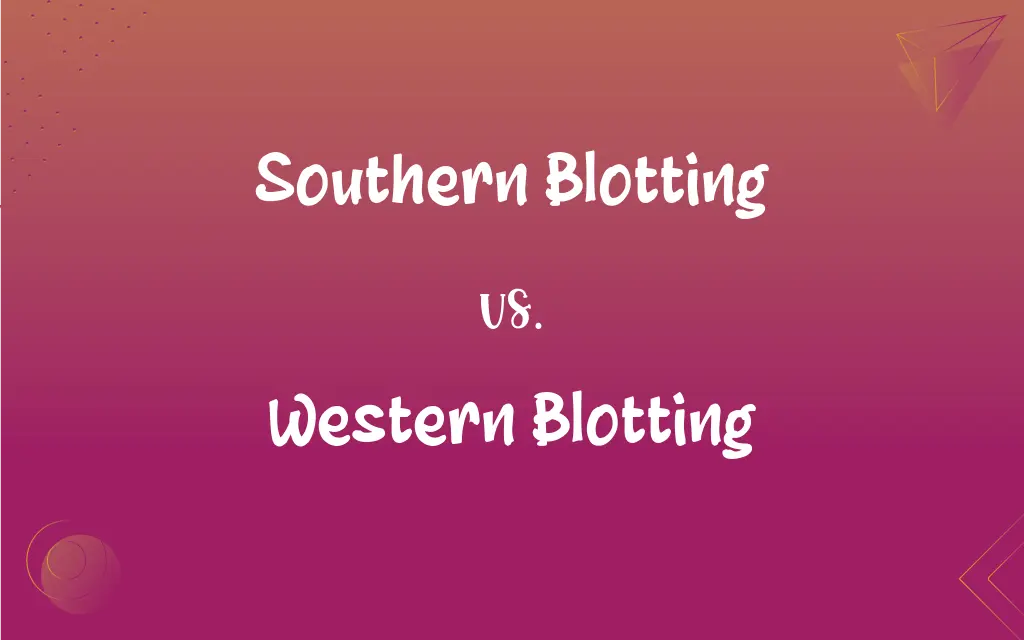Southern Blotting vs. Western Blotting: What's the Difference?
Edited by Aimie Carlson || By Harlon Moss || Updated on October 20, 2023
Southern blotting detects specific DNA sequences, while western blotting identifies proteins.

Key Differences
Southern blotting and western blotting are two essential techniques used in molecular biology, with distinct purposes. Southern blotting is named after its inventor, Edwin Southern, and it's a method used to detect a specific DNA sequence in a DNA sample. On the other hand, western blotting is a technique used to detect specific proteins in a sample.
While both southern blotting and western blotting involve the transfer of molecules to a membrane and subsequent detection using probes, the molecules they target differ. Southern blotting focuses on DNA, separating it through gel electrophoresis before transferring it to a membrane. Conversely, western blotting involves separating proteins by gel electrophoresis, followed by transferring those proteins onto a membrane.
Another fundamental distinction is the probes they employ for detection. In southern blotting, DNA probes, which are complementary to the target DNA sequence, are used. This probe hybridizes with the target DNA, facilitating its detection. Western blotting, in contrast, utilizes antibodies specific to the protein of interest, allowing for its identification on the membrane.
A shared goal of both southern blotting and western blotting is to provide qualitative and semi-quantitative data regarding the molecule of interest. Southern blotting can reveal the presence of specific DNA sequences, and potentially their copy numbers, within a genome. In contrast, western blotting can determine the presence and approximate quantity of specific proteins in a sample.
Applications of the two techniques vary based on their unique strengths. Southern blotting often finds utility in genetic fingerprinting, gene discovery, and the study of gene organization. Western blotting is frequently used in the diagnosis of diseases, the verification of gene expression at the protein level, and in research related to protein function and interactions.
ADVERTISEMENT
Comparison Chart
Target Molecule
DNA
Proteins
Separation Method
Gel electrophoresis of DNA
Gel electrophoresis of proteins
Probes Used
DNA probes
Antibodies
Primary Purpose
Detection of specific DNA sequences
Detection of specific proteins
Common Applications
Genetic fingerprinting, gene discovery
Disease diagnosis, verifying gene expression
ADVERTISEMENT
Southern Blotting and Western Blotting Definitions
Southern Blotting
A method to detect DNA sequences.
Researchers used southern blotting to identify the presence of the gene of interest.
Western Blotting
A technique to identify proteins.
The lab used western blotting to confirm the expression of the protein post-transcription.
Southern Blotting
Provides qualitative DNA data.
Southern blotting revealed the multiple copies of the gene within the sample.
Western Blotting
Gives semi-quantitative protein data.
The western blotting results indicated elevated levels of the inflammatory protein.
Southern Blotting
Essential for genetic studies.
In their genetic fingerprinting study, the team relied heavily on southern blotting.
Western Blotting
Transfers proteins to a membrane.
Following gel electrophoresis, western blotting helped visualize the proteins.
Southern Blotting
Uses DNA probes for detection.
The specific DNA sequence was pinpointed with the help of a radiolabeled probe in southern blotting.
Western Blotting
Valuable in disease diagnostics.
Western blotting is a standard procedure in HIV testing due to its accuracy.
Southern Blotting
Involves transferring DNA to a membrane.
After gel electrophoresis, the DNA was analyzed using southern blotting.
Western Blotting
Employs antibodies for detection.
Using a specific antibody in western blotting, the scientist pinpointed the desired protein.
FAQs
How are molecules separated in western blotting?
In western blotting, proteins are separated by gel electrophoresis.
Who is southern blotting named after?
Southern blotting is named after its inventor, Edwin Southern.
What is the main focus of western blotting?
Western blotting identifies specific proteins in a sample.
Can western blotting quantify proteins?
Western blotting provides semi-quantitative data on protein levels.
How is the DNA denatured in southern blotting?
In southern blotting, DNA is often denatured using alkaline conditions.
Can western blotting determine protein modifications?
Yes, western blotting can detect post-translational modifications using specific antibodies.
Why would a researcher choose western blotting over other methods?
Western blotting is chosen for its specificity in detecting particular proteins.
What's a challenge in western blotting?
Selecting the right antibody and ensuring specificity can be challenging in western blotting.
What's a primary application of southern blotting?
Southern blotting is often used for genetic fingerprinting.
How are the samples prepared in western blotting?
In western blotting, samples are denatured and separated by size using gel electrophoresis.
Are there other "blotting" techniques besides southern and western?
Yes, there's also northern blotting for RNA detection.
What does southern blotting detect?
Southern blotting detects specific DNA sequences.
What type of probes does southern blotting use?
Southern blotting uses DNA probes for detection.
How is the molecule of interest visualized in southern blotting?
In southern blotting, a radiolabeled or fluorescent DNA probe helps visualize the target DNA.
How does western blotting aid in disease diagnosis?
Western blotting can identify the presence or absence of specific disease-related proteins.
Which blotting technique is older, southern or western?
Southern blotting was developed before western blotting.
How do you choose between southern and western blotting for a study?
The choice depends on the molecule of interest: DNA (southern) or proteins (western).
Are southern and western blotting still widely used in research?
Yes, both techniques remain fundamental in molecular biology and biomedical research.
What distinguishes the probes in western blotting?
Western blotting utilizes antibodies specific to the protein of interest.
How do southern and western blotting compare in purpose?
Southern blotting identifies DNA sequences, while western blotting detects proteins.
About Author
Written by
Harlon MossHarlon is a seasoned quality moderator and accomplished content writer for Difference Wiki. An alumnus of the prestigious University of California, he earned his degree in Computer Science. Leveraging his academic background, Harlon brings a meticulous and informed perspective to his work, ensuring content accuracy and excellence.
Edited by
Aimie CarlsonAimie Carlson, holding a master's degree in English literature, is a fervent English language enthusiast. She lends her writing talents to Difference Wiki, a prominent website that specializes in comparisons, offering readers insightful analyses that both captivate and inform.































































